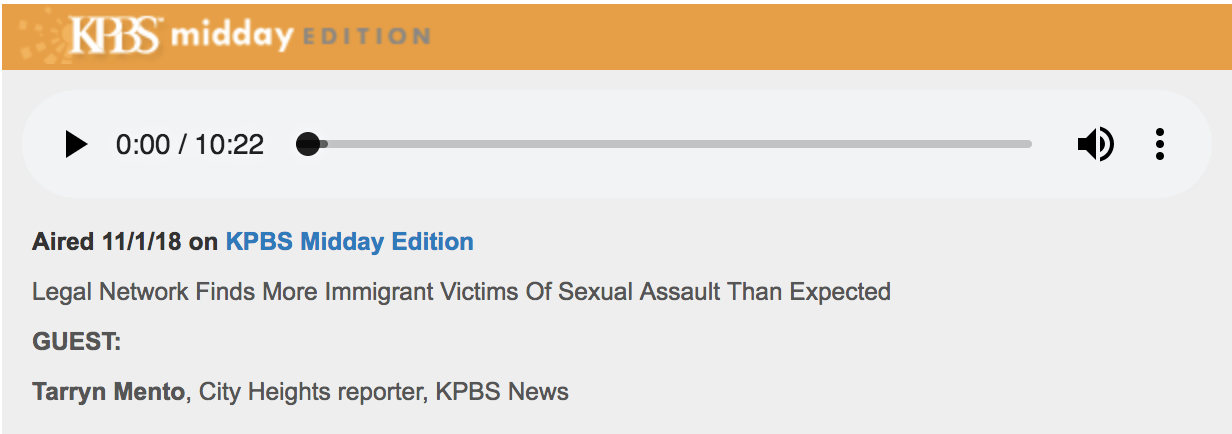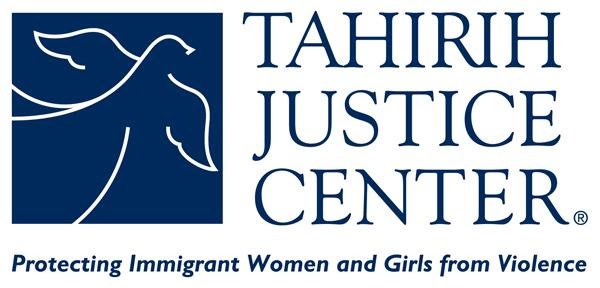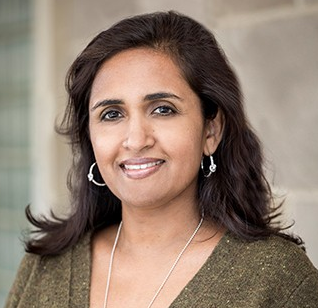December 2018 Newsletter
Sexual Assault 7.3
Westy Egmont, Director IIL
Immigrant women and children are particularly vulnerable to sexual assault, and the provider community plays a vital role in protection, education, and intervention. Fear of authorities and increasingly harsh treatment by ICE and police add complexity to issues of language and ignorance of the laws.
Amnesty International reports that over 60% of women migrating north from Central America at the beginning of this decade were assaulted. Another study that looks at the broader issue of harassment and violence by Reveal, a publication of the Center for Investigative Reporting, summarizes one study of 150 female farmworkers where 24% reported sexual coercion by a supervisor. The Southern Poverty Law Center has been addressing this for years. Sadly, the government is part of the problem. The New York Times covered abuse in the youth detention facilities by two staff, and with the US government now holding 14,000 children, there is widespread concern about vetting staff fully.
All who suffer from sexual assault experience pain and trauma. Is the immigrant perspective different? Most evident is the legal context. This month thirty former state and federal judges have called for courthouses to be “sensitive locations” where ICE will generally not go. This safe policy has been in effect for the last 25 years—having only recently been reversed. Judges report that arrests by ICE in or at courthouses have impacted survivors of domestic violence, child protection cases, and even human trafficking. ICE justifies their actions based on some agencies being “unwilling…to cooperate in enforcement.”
Given that most victims know their assailants, the problem expands into complex dependencies and a fear of consequences for children and even relatives in the homeland if there is gang involvement. The provision of safe, protective environments addresses immediate needs, but a real or perceived sense of threat to survival often complicates interventions. Cases in which the victim is told they will be deported if they report the crime are common.
A colleague from Somalia shares that, when accompanying a woman to a hearing, she found the male defendant accompanied by a score of fellow Somali who judged the victim as overreacting to the violence--the violence they perceived as culturally familiar. Community mores and victim blaming can stifle action, limiting needed support for those who seek the protection of the court and whose fear of isolation is real intimidation.
Immigration protection is afforded to many of those who come forward, but research amply shows only a low percentage of those who turn to professionals for assistance. The New York Times chronicles the decline of reporting of abuse, down 40% in Houston for example. This is not due to a decline in assaults because of #MeToo awareness by perpetrators. Rather, there is fear that the protection desired from stepping forward will not be offered, and will result in another form of abuse leading to deportation. Few academic studies have examined the consequences experienced by immigrant victims and the options they are given. Even in Know Your Rights work, few resources have been created to reach minority language groups to educate and direct them to safe providers.
This subject also impacts male victims, including many young boys, with male rape in the immigrant community accompanied with additional layers of shame and silence. Specific research is again scarce, but the National Intimate Partner and Sexual Violence Survey is a sound starting point. ‘Unwanted sexual contact, violence, penetration’ are terms reflecting levels, casually amalgamated in statistics, but in this time, they warrant clarity of definition to understand prevalence rates, consequences, and interventions.
Whether it be an event or a prolonged experience of abuse by an individual, a cartel or a government, oppression is rampant and humane care is too seldom found. As service providers, we must ask ourselves what role we can play to integrate immigrant survivors of sexual assault. VAWA, in materials available through the National Immigrant Women’s Advocacy Project, focuses on the critical role of SART teams. Breaking Barriers is a comprehensive tool that provides information that will be useful to advocates, attorneys, justice and social services professionals in working with and assisting immigrant survivors of domestic and family violence.
The provisions of VAWA, education of court officers, increased justice and expanded general support of those abused are improving the options for immigrants. Among the myriad of issues still begging for further attention is action within the faith community to address the rights and value of all persons. In cosmopolitan cities like Boston, imams, pastors, and priests have attended training events to understand the high risks and their potential roles. Intervention strategies by groups such as the Peaceful Families Project call for training and active roles by faith leaders.
Linguistic minorities face enormous problems. Often they do not read the educational information available, so lack of knowledge about services is high even if the right to receive help would be a reasonable expectation. Even good service providers lack the multi-lingual staff to provide critical assistance at first contact or in group settings. As simple a step as having pre-taped information on phone lines with linguistic options about what to do can be lifesaving. Shield of Athena in Montreal is an outstanding example of providing phone access and multilingual staffing. For English speakers, the notable hotline, created in 1994, is the National Sexual Assault Hotline (800-656-HOPE and online.rainn.org) which has helped more than 2 million people affected by sexual violence.
The exemplary agency this month is Tahirih, the only national organization (located in five cities) that addresses the issue with a broad range of direct legal services, policy advocacy, and training and education to protect immigrant women and girls fleeing gender-based violence.
Given the IIL’s commitment to immigrant integration, those hurt while trying to build a new life, those most at risk of being left behind, and those left outside current human services are a particular priority. It falls to each community, to networks of providers, immigrant rights groups, funders, and survivors, to organize appropriate services and ensure the presence and information distributed by those working with compassion, skill and the necessary knowledge of immigrant barriers and particular legal needs. This will advance the protection and care of those coping with the betrayal of trust, values, and decency in crimes of assault.
Research
Sjöberg, M., & Sarwar, F. (2017). Who gets blamed for rapes: Effects of immigration status on the attribution of blame toward victims and perpetrators. Journal of Interpersonal Violence.
Blame, which is influenced by a number cultural factors, can contribute to weather a survivor of sexual assault seeks services or even tells anyone of the assault. This study highlights that gender and immigration history influence one’s perception of sexual assault and its consequences. The researchers found that immigrant populations generally attribute more blame to victims than to perpetrators. In general, a victim who is an immigrant likely feels more shame and guilt than the perpetrator. Overall, women attributed more perpetrator blame to men and men attributed more victim blame to women. The implications of these findings are that immigrant victims and perpetrators have different perceptions of their experiences with intimate partner violence. For victims, this may influence the level of medical and legal assistance they seek following an assault, while for perpetrators, this may influence the level of blame they are willing to accept. Social workers must be aware of these differences as they work with immigrants and should be proactive in pushing back against victim-blaming attitudes among immigrants that discourage victims from receiving help.
Kim, T., Draucker, C. B., Bradway, C., Grisso, J. A., & Sommers, M. S. (2017). Somos hermanas del mismo dolor (We are sisters of the same pain): Intimate partner sexual violence narratives among mexican immigrant women in the United States. Violence Against Women, 23(5), 623–642.
Victims of intimate partner violence (IPV) in different cultures experience assaults differently than victims in the United States. In this study, researchers analysed the transcripts of nine Mexican women who immigrated to the United States and had experienced (IPV) at some point in their lives. A key trend across each transcript was that women conceptualized their experiences of IPV in three major narratives: The Virgin and the Whore, The Family, and Getting Ahead. In the Virgin and the Whore theme, women conceptualized their experiences of IPV with feelings of shame. In the Family theme, women conceptualized their experiences of IPV through the lense of complicated family dynamics. In the Getting Ahead theme, women conceptualized their experiences of IPV as part of their drive to migrate, separate from abusive partners, and start healthy relationships. Another key finding of this article was the idea that transitions in the form of migration were not as significant in women’s experiences of IPV as researchers had anticipated. Instead, women viewed emotional transitions as more significant than crossing a physical border. This article has important implications for social workers, as it highlights how immigrant woman may conceptualize their experience with domestic and sexual violence in ways that differ from non-immigrant women.
Tsong, Y., & Ullman, S. (2018). Asian American women sexual assault survivors’ choice of coping strategies: The role of post-assault cognitive responses. Women & Therapy, 41(3-4), 298-315.
Even though one in three Asian American and Pacific Islander women experiences sexual assault, there is sparse research about their coping responses. This study addressed that gap and found that Asian American and Pacific Islander women used acceptance and self-distraction the most as coping mechanisms. Survivors who perceived control over their recovery had the best outcomes. In contrast, survivors who perceived less control used more maladaptive coping strategies, such as misusing substances and disengaging. Those who used these maladaptive coping strategies had poorer outcomes. Given that the Asian American and Pacific Islander population is growing and that they experience sexual assault at such high rates, social workers should be familiar with the their coping styles and screen for sexual assault when they are present. This fact is made even more important by the study's acknowledgement that this population utilizes mental health services at a lower rate than other minority groups.
Ramirez, N., & Monk, G. (2017). Crossing borders: Narrative therapy with undocumented Mexican women on a journey beyond abuse and violence. Journal of Systemic Therapies, 36(2), 27-38.
Due to the many negative and harmful narratives of undocumented immigrants and sexual assault survivors that exist in society today, Narrative Therapy may be a useful modality for working with undocumented survivors of sexual assault. The clinicians in this article discuss the resourcefulness of using Narrative Therapy in their practice with immigrant survivors of sexual assault from Mexico. Narrative therapists, who acknowledge how dominant discourses can influence clients presenting problems, also use techniques to externalize the assault and focus on what is meaningful to the client (e.g. cultural pride, resiliency). Clinicians can uncover alternative, preferential stories about the client through absent but implicit techniques, which allow clients to feel validated, re-author their story according to what they value, and recover from sexual assault.
Resources on Sexual Assault
Spotlights
Related Events
A Scan of the Field: Learning about Serving Survivors of Human Trafficking
Online: January 10, 2019
1:00 PM–2:30 PM (EST) • Free
The Intersections of Oppression and Sexual Violence
East Hartford, CT: February 12, 2019
9:30 AM–3:30 PM • $40
U’s and VAWAs with Criminal Convictions
Online: February 26, 2019
2019 International Conference on Sexual Assault, Intimate Partner Violence, and Increasing Access
San Diego, CA: April 22-25, 2019
$495
Helping Those Released from Family Detention: Asylum Options for Immigrant Survivors of Domestic and Sexual Violence
Pre-Recorded Webinar: Available Now
Free
Immigration 101: A Webinar for Domestic Violence Victim Advocates
Pre-Recorded Webinar: Available Now
Free
Legal Protections and Forensic Considerations for Immigrant and Refugee Child Victims
Pre-Recorded Webinar: Available Now
Free






